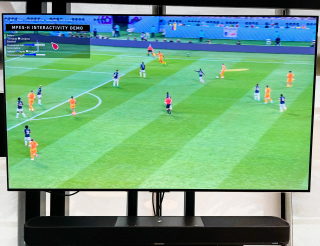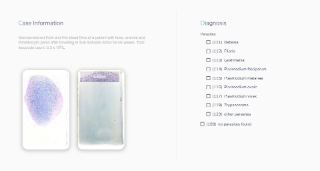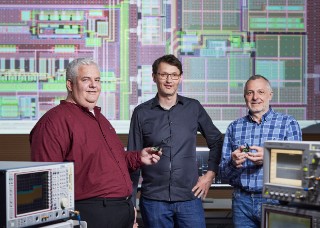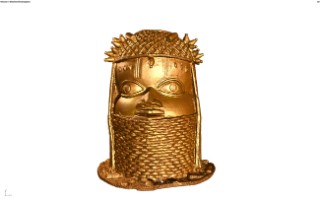The digitization of cultural-historical objects cannot replace the original. Nevertheless, there are many reasons to use state-of-the-art technology to create three-dimensional models of historically significant objects. At the Fraunhofer Development Center X-ray Technology EZRT at Fraunhofer IIS, bronze reliefs from West Africa were translated into digital data sets using industrial X-ray computed tomography in collaboration with the Staatliche Museen zu Berlin. The digitization of the first museum pieces demonstrated the feasibility of the project.
more infoPressroom
Search for press releases
Search for search term and date or just for date.
-

The Development Center X-ray Technology EZRT of the Fraunhofer Institute for Integrated Circuits IIS will host the twelfth Conference on Industrial Computed Tomography iCT 23 from 27 February to 2 March 2023. A staple event for more than ten years, the conference offers participants from industry and research a forum for mutual dialogue. iCT 23 will take place at Stadthalle Fürth, where around 200 experts from all over the world are expected.
more info -
Latin America’s largest media group, Grupo Globo, is driving the change of media production, transmission, and consumption to a future-proof system. Now, they take another major step in the Digital TV evolution in Brazil and bring the SBTVD TV 2.5 standard into reality.
more info -

Fraunhofer supports its partners worldwide in setting up live transmissions of the football tournament with a new level of audio experience: Immersive sound and different personalization options.
more info -

Fraunhofer Institute for Integrated Circuits IIS is proud to announce that the LC3plus codec has received the highly valued Hi-Res Audio Wireless certification issued by the Japanese Audio Society.
more info -

Grenoble: The electron synchrotron facility in Grenoble has put into operation a globally unique synchrotron-based computed tomography system for the non-destructive testing of large components. Mario Brandenburg (FDP), The Parliamentary State Secretary of the German Federal Ministry of Education and Research (BMBF), opened the new beamline during an official ceremony. The system offers a resolution of 25 micrometers, which puts it well ahead of the previous standard resolution for large components. Through its Development Center X-ray Technology division (EZRT), Fraunhofer IIS is playing a leading role in the development of the measuring station. The project is being funded by the German Federal Ministry of Education and Research with 6.3 million euros.
more info -

At WindEnergy 2022 in Hamburg, institutes of the Fraunhofer Cluster of Excellence for Cognitive Internet Technologies CCIT will demonstrate how sustainable energy can even be efficiently and sustainably monitored and maintained. With the Q-Bo® technology, Fraunhofer scientists show how bolted joints and screws, e.g. on the rotors or tower flanges of wind turbines, can be maintained without consuming large amounts of energy for installation, operation and transmission. This means that maintenance cycles for onshore and offshore wind turbines can be made many times more targeted and cost-efficient.
more info -
Fraunhofer IIS and Astrodesign cooperate to offer JPEG XS solutions for video equipment manufacturer
Fraunhofer IIS and Astrodesign Inc. announce their partnership at IBC 2022 to offer JPEG XS based solutions either as an FPGA IP core or as a software solution. Both parties are permitted under a cross licensing agreement to sublicense the other's party technology. They will demonstrate the JPEG XS encoding/decoding process and its interoperability by an encoder FPGA solution from Astrodesign together with a software decoder application based on Fraunhofer's SDK (Software Development Kit).
more info -

The Fraunhofer Institute for Integrated Circuits IIS and the Bernhard Nocht Institute for Tropical Medicine (BNITM) have developed ParasiteWeb®, a web platform for training and quality assessment of parasite microscopy. With digital clinical samples, the platform makes it possible to train diagnostic skills online and run virtual external quality assessments (EQAs). In this way, ParasiteWeb® can reach a wider group of users and offer them access to rare parasites and direct expert feedback. With Nobit oHG as a partner, ParasiteWeb® is now live: www.parasiteweb.com
more info -
At IBC 2022 in Amsterdam, the video coding experts of the Fraunhofer Institute for Integrated Circuits IIS announce and demonstrate their JPEG XS SDK 5.0 solutions achieving a 25% acceleration for en- and decoding of 4k/8k images on x86 CPUs, ARM CPUs, and NVidia GPUs. Due to a more streamlined parametrization and optimization, they are able to provide an essential performance increase. The Fraunhofer IIS SDK also allows MXF support in accordance with SMPTE ST2124.
more info -
Erlangen, Germany / Hsinchu, Taiwan / Sao Paulo, Brazil: MediaTek, a leading fabless semiconductor company, and Fraunhofer IIS, primary developer of the MPEG-H 3D Audio standard, have once again collaborated for bringing the most advanced audio experience to consumer homes.
more info -
Developed at the Fraunhofer Institute for Integrated Circuits IIS and used around the world, the SHORE® facial detection and emotion analysis software library is turning 15 years old. Fraunhofer IIS is marking the occasion by releasing a new version with additional features. SHORE® uses highly efficient AI algorithms that enable image-based analysis of human expressions in line with German and EU data protection standards. The technology has a wide range of applications, including gaining insights into psychological disorders and researching the effects of advertising.
more info -

Robust transmission of sensor data for condition monitoring and smart metering – this is what recommends the wireless and standardized transmission technology mioty from the Fraunhofer Institute for Integrated Circuits IIS for applications in the Industrial Internet of Things (IIoT). But it can do even more: it enables hundreds of thousands of sensors to be connected via just one base station. This is a huge advantage, especially in the smart city and smart building sectors with many end devices. Using mioty, 3.5 million messages per base station can be read out and transmitted per day.
more info -

Keeping things constantly connected to the internet costs energy — a lot of energy. Even small Internet-of-Things nodes run out of battery entirely in just a few weeks. All of this is changing with the RFicient® chip, developed by the Fraunhofer Institute for Integrated Circuits IIS, which saves power consumption by up to 99 percent. This development is a big step forward for the Internet of Things and has secured the Joseph von Fraunhofer Prize for the developer team. The Prize is awarded to employees of the Fraunhofer-Gesellschaft for their outstanding scientific achievements in solving application-related problems.
more info -

Erlangen/Rosenheim: On May 5, 2022, the Fraunhofer Institute for Integrated Circuits IIS officially opened its 5G Bavaria automotive test bed. In a five-kilometer test area located on the southern edge of the Bavarian city of Rosenheim, automotive companies now have the opportunity to put 5G functions for connected driving through their paces in a realistic environment.
more info -

The Fraunhofer Institute for Integrated Circuits IIS announces its ultra-low-latency software implementation of JPEG XS on DELTACAST´s video I/O solution with a latency far below one frame. This will allow broadcast equipment developers and implementers to benefit from JPEG XS in terms of low latency but also low complexity within their devices and equipment. It will boost the possibility to transmit extremely high-quality images and videos over IP and to set up collaborative, remote processes within a broadcast or professional video production environment.
more info -
Erlangen, Germany; Mont-Saint-Guibert, Belgium; London, UK: Fraunhofer IIS and intoPIX, the main JPEG XS standard patent holders, announce the creation and availability of a JPEG XS patent pool administered by Vectis IP. The new pool enables manufacturers, developers, and implementers to efficiently license JPEG XS standard essential patents using the framework of fair, reasonable, and non-discriminatory licensing. JPEG XS is the new lightweight low latency codec that can be used to improve connectivity in video workflows.
more info -
The Brazilian SBTVD Forum recently finalized the technical evaluation phase of the TV 3.0 Project for the definition of the next-generation television system in Brazil. It comprised a detailed technical evaluation of all proposed technologies. As a result, the MPEG-H Audio system was selected as the sole mandatory audio codec for the future Brazilian broadcast system.
more info -
Grupo Rede Amazônica is the first broadcaster in Latin America to provide a 24/7 MPEG-H Audio service on one of their terrestrial broadcast channels.
more info -

Erlangen, Germany/Austin (TX), USA: The standardized Fraunhofer mioty protocol stack for Low Power Wide Area Networks (LPWAN) and IoT applications is implemented and tested in the newly introduced wireless bidirectional sub-GHZ SoC (System on Chip) Series 2 platform EFR32FG23 (FG23) from Silicon Labs. The single-die, multi-core solution presents extremely low transmit and receive radio power together with robust RF performance and deep indoor penetration
more info -
Fraunhofer IIS, primary developer of the MPEG-H 3D Audio standard, announced today that Sony Corporation (Sony) has licensed Fraunhofer’s MPEG-H 3D Audio Baseline Profile Decoder software and joined the MPEG-H Trademark Program.
more info -
The Fraunhofer Institutes IIS and IAF together with the University of Freiburg/INATECH win second place with their joint project “EdgeLimit – Evaluation of Power Electronics in Modern Edge Cloud Systems” in the innovation competition “Electronics for Energy-Saving Information and Communications Technology” launched by the German Federal Ministry of Education and Research (BMBF). The project consortium is funded by the BMBF to realize their solution for energy-saving mobile radio base stations.
more info -
Erlangen, Germany: mioty® communication technology enables the simultaneous transmission of data packets from a large number of sensor nodes over long distances and is particularly energy efficient. Previously, providing the Internet of Things (IoT) in a terrestrial network was limited to a range of up to 15 kilometers. Now, transmission tests by the Fraunhofer Institute for Integrated Circuits IIS in Erlangen, Germany, have shown that mioty® can be used via geostationary (GEO) satellites – without having to adapt the wireless protocol. Deploying the IoT via satellite allows the range of a network to be extended at will, up to and including around the globe.
more info -
A jointly operated system that allows European states to maintain regional sovereignty is needed to ensure the responsible and innovative management of data from business, organizations and public administration. This is the argument put forward in the position paper entitled “Federal structures in data management,” published by the Fraunhofer Cluster of Excellence Cognitive Internet Technologies CCIT in early June 2021 (in German). Prof. Alexander Martin, Director of the Fraunhofer Institute for Integrated Circuits IIS, played a leading role in composing the document and formulating the recommendations for action it contains for policymakers and industry.
more info -

What all of us want is good air to breathe, healthy animals out to pasture and fertile arable land. How can the Internet of Things (IoT) help us solve such challenges, especially when climate change is making them all the more urgent? Within the project, the FutureIOT center of excellence, which is funded by the Bavarian Research Foundation, developed solutions for animal health, parking space management, air quality measurement and connected sensor technology for fields.
more info -
In order to meet the quality expectations of their users, high-end consumer electronics manufacturer Bang & Olufsen decided on the new open standard LC3plus codec from Fraunhofer IIS for their wireless streaming devices. LC3plus is currently the most advanced solution that com-bines high-resolution audio with low delay.
more info -

The networking of objects in the Internet of Things — or IoT for short — is becoming increasingly important, and demand for connected IoT devices is growing rapidly everywhere, from consumers to Industry 4.0. But until now, no suitable and reliable method of communication has been available for transferring many thousands of data packages at the same time. A team of researchers from the Fraunhofer Institute for Integrated Circuits IIS in Erlangen/Nuernberg has now overcome this challenge with the newly developed, ready-for-market mioty® wireless low-power wide-area transmission system. The team receives the Joseph von Fraunhofer Prize, which is awarded to employees of the Fraunhofer-Gesellschaft for their outstanding scientific achievements in solving application-related problems.
more info -
Starwaves, a developer and distributor of receiver technologies centered around the digital broadcast standard DRM (Digital Radio Mondiale), joined forces with Fraunhofer IIS, a leading supplier in the field of broadcast encoder and receiver components for DRM, to develop an Android app that allows DRM reception on mobile devices. Starwaves enables Android phones and tablets to receive entertainment, text information, and emergency warnings via DRM Digital Radio – without costly data plans, independent from cell phone network availability, and based on innovative Fraunhofer technology.
more info -
Erlangen, Germany: Fraunhofer IIS, primary developer of the xHE-AAC audio codec and long-time member of the ATSC as well as the DRM Consortium, and Sinclair Broadcast Group (Nasdaq: SBGI), a diversified media company and leading provider of local sports and news in the U.S., are joining forces to bring the best possible DRM digital radio experience to users of the ATSC 3.0 digital TV platform.
more info -
What do localization and networking have in common with the Internet of Things? Both technologies are the basis for interactive and self-sufficient Industry 4.0 processes and smart mobility applications. A self-calibrating localization system allows flexible processes, tools, driverless transport systems, assembly systems etc. set-up, re-design and adapt to new work processes easily and in real time - in the production hall as well as outdoors. Beautiful vision or reality? The Fraunhofer Institute for Integrated Circuits in cooperation with the Fraunhofer CCIT Research Center IoT Comms will show how this can be achieved at Hannover Industry Trade Show 2021. For this, the localization and communication specialists will present technologies and solutions as well as a unique 5G testbed for Industry 4.0, in which companies can already realize and experience tomorrow today.
more info
